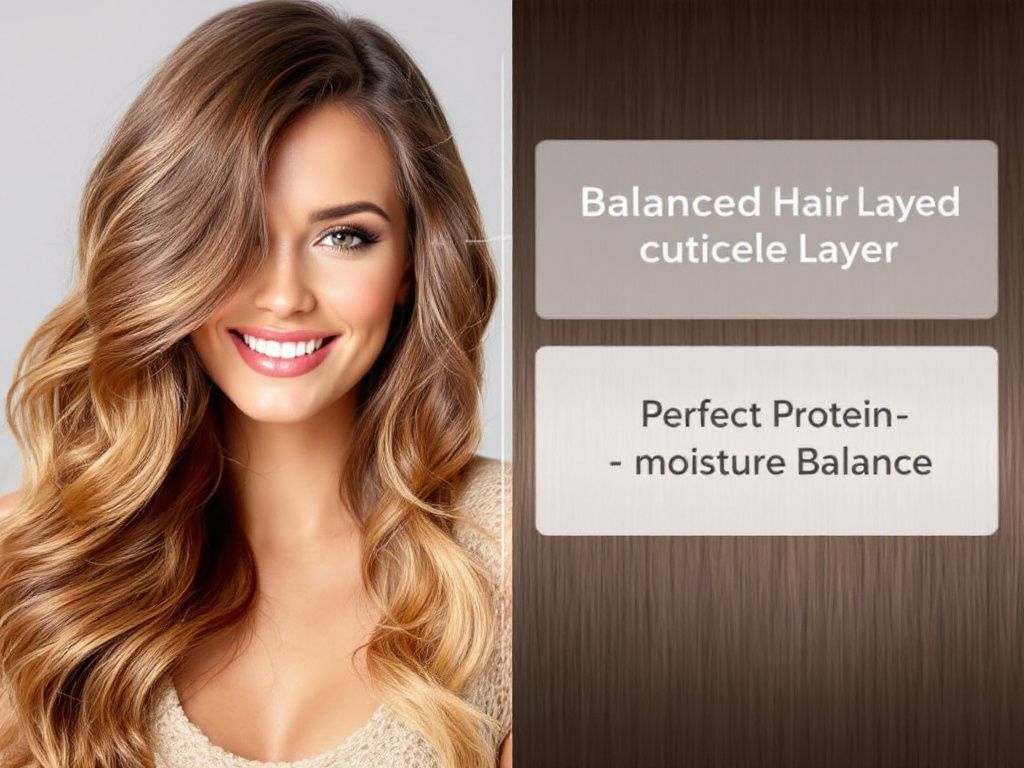
Discovering your hair’s porosity is like finding the key to unlocking your hair care potential. This often-overlooked aspect influences how products interact with your hair and can be the secret to achieving the luscious hair you’ve been aiming for. By mastering the science of hair porosity, you can tailor your regimen effectively, ensuring your hair maintains the perfect protein moisture balance. Let’s delve deep into the science of porosity, including how to test and treat your hair the right way.
Understanding Hair Porosity: A Chemistry Lesson
Before diving into the how-to’s, let’s establish what hair porosity is. In simple terms, porosity refers to your hair’s ability to absorb and retain moisture. Hair porosity impacts everything from styling outcomes to the product efficacy. Scientifically speaking, it relates to the cuticle, the outermost layer of the hair shaft, which determines how porous your hair is.
**Types of Hair Porosity**:
- Low Porosity 🌼: Hair with tightly packed cuticles. This type resists moisture absorption since the cuticle layers are compact, making it difficult for water and products to penetrate. Protective hairstyles for hair ends can be especially beneficial for maintaining this type of hair.
- Medium/Normal Porosity 🌟: Hair with a balanced cuticle layer that can absorb moisture efficiently without significant difficulty. It retains moisture well but isn’t resistant to over-absorption.
- High Porosity 💧: Hair with gaps and holes in the cuticle layer, often caused by damage or over-processing. It absorbs moisture easily but can struggle to retain it, leading to dryness and frizz. Using the best hair serums for shine and frizz control can help manage this porosity level effectively.
**Scientific Insight**: According to a study published in the *Journal of Cosmetic Science*, the porosity of hair significantly influences the diffusion rates of oils and water into the hair shaft (Barel, et al., 2014). Therefore, understanding and adjusting your routine based on porosity is critical for effective hair care.
How to Conduct a Hair Porosity Test at Home
Conducting a hair porosity test at home is straightforward:
1. The Float Test
This simple test only requires a few strands of clean, dry hair and a glass of water.

**Steps**:
- Place a single strand of clean hair in a glass or bowl of water.
- Allow it to sit for 2-4 minutes.
- Observe the hair’s behavior in water:
– **Floats on top**: This indicates low porosity.
– **Sinks to the middle**: A medium/normal porosity.
– **Sinks to the bottom**: Indicates high porosity.
**Expert Tip**: Ensure the hair is product-free for accurate results, since residues of conditioners or oils might weigh down the strand, leading to false conclusions. For those interested in hair growth, using hair growth shampoo secrets can complement your porosity care routine.
2. The Slide Test
The slide test provides a tactile understanding of cuticle condition.
**Steps**:
- Glide your fingers upwards along a strand of hair, moving from tip to root.
- Notice the texture:
– **Smooth with difficulty**: Suggests low porosity (cuticles are tightly closed).
– **Smooth, moderate roughness**: Moderate porosity.
– **Rough texture**: High porosity (cuticles are raised).
Both tests are good indicators; however, remember they merely provide a general idea and not an absolute revelation. For additional hair care tips, the lazy girl’s guide to flawless hair offers practical viral hacks that actually work.
Treating Your Hair According to Its Porosity
Now that you’ve identified your hair’s porosity, it’s time to treat it accordingly for optimal health and aesthetics:
Low Porosity Hair Care 🌼
**Challenges**: When your hair has low porosity, it often repels moisture, and products can build up on your hair rather than saturating it.

**Care Routine**:
- Clarifying Shampoos: Use clarifying formulas weekly to prevent residue build-up. For sensitive scalps, consider shampoo sensitive scalp best options to avoid irritation.
- Warm Up Your Treatments: Apply heat to help open the cuticle. Consider warm oil treatments or a steam cap to allow deeper penetration.
- Lightweight Moisturizers: Lighter, water-based products are preferable, ensuring they do not sit on the surface.
Medium Porosity Hair Care 🌟
**Advantages**: This porosity level requires less aggressive care, as the cuticles accommodate moisture and sealing better.
**Care Routine**:
- Regular Regimen: Continue regular conditioning routines without the need for heavy products. Using slip hair products tangle free hair can help maintain manageability.
- Balance Between Moisture and Protein: Products maintaining protein moisture balance are ideal to keep the optimal porosity level stable. Look for balanced conditioners and treatments.
High Porosity Hair Care 💧
**Challenges**: High porosity often leads to frizz and dryness due to cuticles that allow too much moisture.
**Care Routine**:
- Protein Treatments: Weekly treatments to strengthen and repair cuticle gaps. A commonly suggested treatment is hydrolyzed protein masks which bond easily due to the smaller molecular size.
- Thick, Emollient Conditioners: Use products rich in natural oils (argan, jojoba), butters (shea, cocoa), and silicones for better cuticle sealing.
- Leave-in Conditioners: Apply leave-in treatments alongside your daily regimen to maintain moisture levels and seal them within the cortex. For heat styling, consider best products for heatless styling tools to avoid further damage.
Real-World Applications & Case Studies
Case Study #1: Professional Salon

At a high-end salon, a detailed understanding of porosity was leveraged to enhance service quality. Following an initial consultation where a stylist performed a porosity test, they customized an in-salon treatment reflecting the client’s specific hair need.
Increased client satisfaction was reported due to more effective treatments and less return for corrections, tying results directly to porosity-sensitive product use (Brand Case Study, 2022). For maintaining styles post-salon, best edge control products can help keep hair sleek and polished.
Case Study #2: Research Data
A 2020 study observed correlations between Asian and African hair types with varying porosities. African hair, often with high porosity, showed enhanced results with protein/moisture targeting whereas Asian hair benefited more from lightweight hydrating systems (Cosmetic Dermatology Journal, 2020). Transition hair products natural can assist those shifting hair care routines during changes in hair texture.
The Balance of Protein and Moisture
Balancing protein and moisture is key to also balancing porosity. Hair can either become too brittle from excess protein or too elastic from over-hydration.
**How to Achieve the Balance**:
- Hydrolyzed Protein Treatments: Incorporate to strengthen the hair, ensuring cuticles are well-formed and not over-proteinized.
- Regular Moisturizing: Incorporate hydrating masks ensuring they are not predominantly protein-based, preventing rare stiffness from occurring. For oily hair types, hair masks oily hair formulations can be beneficial.
Conclusion
Understanding and managing hair porosity is pivotal in achieving your hair’s aesthetic potential and overall health. By utilizing smart porosity tests and adopting tailored care routines filled with scientific insight, you are steering towards hair care that reacts to your specific needs. No longer is hair care a one-size-fits-all! Embrace your hair type and porosity for undeniably noticeable results.
By acting as an informed consumer and participant in your hair’s care, you are fostering stronger, more vibrant growth. Leverage these insights based on industry standards and case-grounded information that ensures your advanced techniques yield nothing but the best results. 🌟
—
**Resources**:
- Barel, A. O., Paye, M., & Maibach, H. I. (2014). Handbook of Cosmetic Science and Technology.
- Cosmetic Dermatology Journal. (2020). “Porosity Related Research in Hair Types”.
- Brand Case Study (2022). “Successful Salon Experiences”.
Frequently Asked Questions
What are the benefits of using a hair mask in my hair care routine?
Using a hair mask can provide several benefits, including hydration, smoothing, strengthening, curl definition, heat protection, and damage repair. Hair masks infuse the hair with moisture, help coat the hair shaft to seal split ends, reduce breakage, and protect the hair from heat styling and environmental damage[1][4].
What ingredients should I look for in a hair mask?
Effective hair masks often include ingredients such as coconut oil, argan oil, shea butter, honey, avocado oil, green tea, and coconut water. These ingredients provide nourishment, moisturize, and protect the hair, offering benefits like softening, moisturizing, and protecting against damage[2][5].
How often should I use a hair mask in my routine?
You should use a hair mask whenever your hair feels dry, unmanageable, or in need of intense hydration. This can vary depending on your hair type and needs, but generally, using a hair mask once or twice a week can help maintain healthy and moisturized hair[1][4].
How do I apply a hair mask for the best results?
To apply a hair mask effectively, shampoo your hair first, then apply the mask, focusing especially on the ends where hair tends to be the most damaged. Leave the mask on for anywhere from 10 minutes to overnight, depending on the type of mask and your hair’s needs[1][4].



Leave a Reply